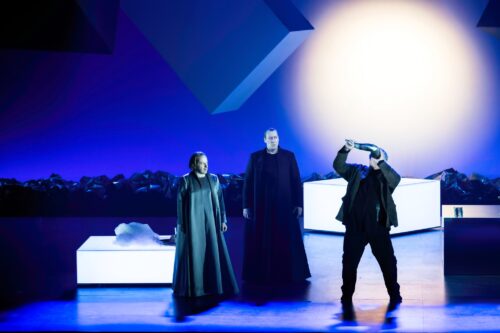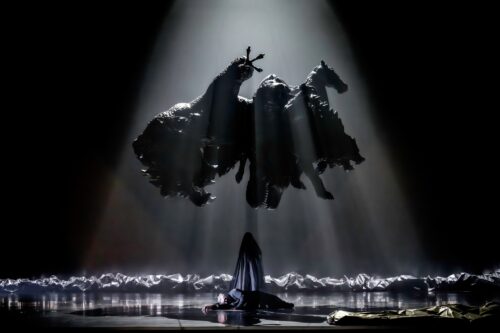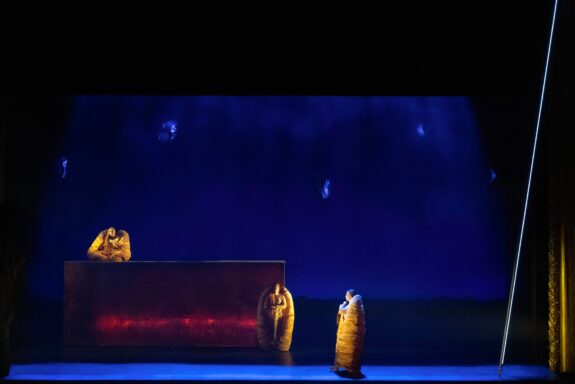 Belgium Wagner, Götterdämmerung: La Monnaie Chorus and Symphony Orchestra / Alain Altinoglu (conductor). Broadcast live (directed by Anaїs Spiro) from La Monnaie, Brussels, 23.2.2025 and available on YouTube or OperaVision until 23.8.2025. (JPr)
Belgium Wagner, Götterdämmerung: La Monnaie Chorus and Symphony Orchestra / Alain Altinoglu (conductor). Broadcast live (directed by Anaїs Spiro) from La Monnaie, Brussels, 23.2.2025 and available on YouTube or OperaVision until 23.8.2025. (JPr)
At the Oper! Awards 2025 recently it was hosting La Monnaie / De Munt was named ‘Best Opera House of 2025’. Ulrich Ruhnke – the jury chair and founder of the awards – cited, amongst much else, La Monnaie’s ‘tremendous attraction and inviting openness that brings both artists and audiences together in the opera house for top creative performances. The selection, level and aesthetics of the productions can more than once be called groundbreaking and also make opera accessible to younger generations’. I have only ‘visited’ once before, admittedly virtually that time too, in 2022 for Puccini’s Il trittico (review here). Their new Ring cycle began in October 2023 with, of course, Das Rheingold and now concludes with Götterdämmerung.
I believe it was possible to watch at a distance the intervening instalments, yet I have only managed to see and hear Götterdämmerung; and that is certainly not the best way to form a lasting impression of any new Ring. And anyway the original director, Romeo Castellucci, left the project halfway through due to creative differences and Siegfried, and now Götterdämmerung, have been staged by Pierre Audi. It is difficult to judge from images of the rest of the Ring how much what Audi now presents relates to Castellucci’s vision for Rheingold and Walküre.
When Audi’s Götterdämmerung ended I realised I had appreciated it most for its musical values rather than its theatrical ones, its storytelling particularly, despite the visual splendour. For good or ill there appears no discerning Konzept. Indeed, with a curtain of fairy lights twinkling red at the end representing the fire consuming Valhalla and all the rest we had seen from Michael Simon’s Cubism-inspired set: what Audi gives us is simply an art installation for the opera to be performed within.
It is a relatively bare set which, it seems, conceals three small turntables which can keep what there is on the stage on the move from time to time. It begins with Chris Kondek’s video showing schoolchildren drawing and playacting some of what has previously happened in the Ring and perhaps emphasising the story’s fairytale elements. When we see the hair-combing Norns they have the appearance to me of woodlice in their duvet-like cocoons, eventually they remove these and are in white nightdresses. On one side of the stage looked to be the trunk of the World Ash Tree, on the other a stage deep illuminated spear and there are two huge gold bars (?) that are frequently on the move. At ‘Es Riss!’ and their (unseen) rope of Destiny breaking, the Norns remove their blonde wigs and are bald. A red sun appears at the back which turns gold as dawn breaks and Siegfried and Brünnhilde are first seen silhouetted. We quickly realise Petra Reinhardt’s costumes will be mostly plain monochrome tunics with mandarin collars and lend a Sci-Fi appearance to all we see, something like old-school Dr Who. The ring is a sizeable nugget of gold and there is an odd cone-shaped Tarnhelm.

When we get to the Gibichung Hall above there a several large cubes and on the stage low pedestals which light up. It has the look of huge blocks of stone that have exploded outward as a prehistoric site has had something catastrophic happen to it. Hagen (like Siegfried) is in black whilst Gunther and Gutrune look almost identical in shiny silver/grey. The twins are clearly more interested in each other than any potential wife or husband. Siegfried enters as if guided by Nothung and is soon manhandling Gutrune. Hagen will force the hands of Siegfried and Gunther down the blade of the sword as they swear blood-brotherhood. At this point Anaїs Spiro’s film breaks any spell the production has created by showing the conductor Alain Altinoglu. When we return to the stage there is a red glow and lightning flashes for the arrival of Waltraute in helmet, black leather and with two shields that are rather like wings and enhance her bird-like moves. On her departure – and with the golden sun behind them – Gunther and Siegfried both with a Tarnhelm rise at the back of the stage, Gunther gesticulates as Siegfried sings. As the act ends it all goes red again as a long spear comes down at the centre of the stage.
Act II opens with more cubes than before and a central rectangular chimney from which Alberich – looking like Nosferatu – emerges. The shadows Valerio Tiberi’s lighting create – notably here of Hagen – adds to an emotionally charged atmosphere. When Hagen summons his vassals, they enter like the pilgrims’ chorus from Tannhäuser in their hooded robes. They carry short staffs that are LED tubes and will either sit on low benches or circle about in an oddly regimented way. When Brϋnnhilde (who had entered in a white wedding dress and long veil) claims she has been betrayed the vassals become very agitated, semaphore and move distractingly. The act ends again with a red glow and that spear coming down.

Act III opens with some more animation and the Rhinemaidens atop one of the ‘gold bars’ wearing bathing caps, swimming costumes (part-shiny, part-sparkly) and flippers. On Siegfried’s entry they remove caps and flippers and put on shiny skirts. The Rhinemaidens’ gesticulations have more than a hint of synchronised swimming about them. Hagen and his men (who will move like automatons) rise at the back of the stage and from above a peculiar sculpture hangs down that I couldn’t entirely make out. It possibly looked like the confused spoils of a hunt, but I am sure there is a horse, wolf … and T. Rex amongst it all. Siegfried’s death scene is initially spoilt by more animated child-like scribblings before he is stabbed in the back by Hagen and Brϋnnhilde enters veiled in black and recovers the ring early as Siegfried bids her farewell. The ‘gold bars’ become prominent again as the opera approaches its end: the now bare-chested Hagen despatches Gunther, it is Brϋnnhilde who now holds up the ring, Hagen breaks Gutrune’s neck, Siegfried’s body is carried out and that spear from earlier descends again. During the final moments Brünnhilde (now in a red dress) wanders to the back of the stage and disappears as the Rhinemaidens wrestle Hagen for the ring before the sun rises on a new world, I presume. Hardly ‘groundbreaking’ stuff!
Obviously I was listening to the opera through loudspeakers, but I was impressed by the playing of the La Monnaie Symphony Orchestra and Alain Altinoglu’s propulsive conducting. It ensured transitions between different scenes were seamless, aurally captivating, and dramatic tension never slackened for a second. Altinoglu was supported by a chorus singing with almost abandoned enthusiasm and generally solid singing – if not much more – from a cast of less familiar, though not any younger, names than we usually get in live-streamed Wagner these days.
The singing is dominated by Ain Anger’s sepulchral bass voice which perfectly matched the malevolent physicality of his interpretation. I heard Bryan Register sing Tristan in 2016 (review here) and I felt his burly sound now lacks a lyric quality and is more suited to that role rather than Siegfried. He was not the only singer showing signs of tiredness after five previous performances and sheer willpower seems to have got him through to his deeply affecting ‘Brünnhilde! Heilige Braut!’ the culmination – and highlight – of his performance. The warmth and richness of Ingela Brimberg’s convincingly portrayed Brünnhilde revealed how she was once a mezzo-soprano. There was a certain unsteadiness and shrillness at times (was she tired too?) and Brimberg never abandoned herself to the role as some of the best Brünnhildes do during Act II and in the Immolation Scene. Nora Gubisch has a deep sounding mezzo-soprano voice and her melodramatic Waltraute seemed from an entirely different opera. Scott Hendricks was an unusually intense – even for that character – Alberich, with Andrew Foster-Williams and Anett Fritsch well-matched as the sexually-conflicted Gunther and Gutrune, and equally excellent trios of Norns (Marvic Monreal’s eloquent mezzo-soprano standing out) and Rhinemaidens completing the ensemble.
Jim Pritchard
Featured Image: Pierre Audi’s Götterdämmerung (Prologue) © Monika Rittershaus
Cast:
Siegfried – Bryan Register
Brünnhilde – Ingela Brimberg
Hagen – Ain Anger
Gunther – Andrew Foster-Williams
Gutrune – Anett Fritsch
Waltraute – Nora Gubisch
Alberich – Scott Hendricks
First Norn – Marvic Monreal
Second Norn – Iris van Wijnen
Third Norn – Katie Lowe
Woglinde – Tamara Banješević
Wellgunde – Jelena Kordić
Flosshilde – Christel Loetzsch
Production:
Director – Pierre Audi
Sets – Michael Simon
Costumes – Petra Reinhardt
Lighting – Valerio Tiberi
Video – Chris Kondek
Choreography – Pim Veulings
Dramaturgy – Klaus Bertisch
Chorus master – Emmanuel Trenque
